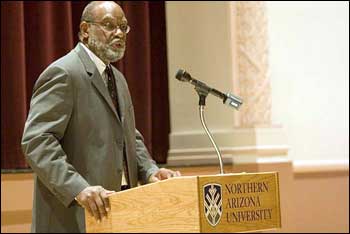
Rufus Glasper undoubtedly has the students. Now he wants to turn them into 250,000 success stories.
Glasper, chancellor of Maricopa Community Colleges, said he believes every student has a “right” to succeed. “We are committed to the notion that if a student doesn’t succeed, it is not because we have failed that student,” he said. “We have to make certain that every student has that chance to be successful.”
Glasper addressed about 85 people in Ashurst Auditorium on Nov. 2 in the second of the four-part President’s Speakers Series.
With nearly 250,000 students, 5,000 faculty and staff and 10 independent colleges, Glasper is chancellor of one of the largest higher education systems in the world. He also seems to have support of the burgeoning region, evidenced by a $950 million bond election that passed overwhelmingly in 2004.
Yet Glasper is not content with playing “footsy” with the community. More accurately, that should be spelled FTSE but pronounced the same way.
FTSE is full-time student equivalent—a measure of how many students attend an institution and often a measure of a university’s accomplishments. Instead, Glasper said, “We need to change the model to change the future, to change to a model of student success.”
He suggests strengthening collaborative efforts among colleges within his own system as well as between MCC and Northern Arizona University. He calls the concept MCC’s new vision, “A Community of Colleges…Colleges for the Community.”
“We have to look beyond traditional and conventional boundaries,” he said. “The memorandum of understanding between Maricopa and NAU allows us to step beyond boundaries.”
NAU has been delivering distance education programs to Maricopa County for more than a quarter of a century, but the memorandum of understanding, signed in April, will give NAU a physical presence on all 10 campuses. It also will solidify and formalize many of the programs and offerings now available as well as open the door for several new programs in the county.
“We want to move from being a good institution to being an outstanding and great institution,” he said.
Glasper discounted the possibility of the Maricopa system requesting authority to grant baccalaureate degrees. “I don’t believe it is time for community colleges to grant baccalaureates,” he said. “Our mission is strong.”
Instead, he explained, a partnership “built on trust” will allow the institutions to “walk together.”
“If NAU continues to show that we will be connected, then I’ll have my hand in your pocket and you’ll have your hand in mine,” he said.
Glasper also is chair of the Governor’s P-20 Council, whose aim is to improve Arizona education from preschool to postgraduate study.
As chair, he hopes to align all school standards with university standards. “The community colleges have an unequaled view and can provide a bridge and clarity of vision for higher education,” Glasper said.
Glasper repeated his mantra of access and opportunity for all levels of education. He also cited what he called a chilling fact that Arizona’s future prison population is predicted by studying third-grade reading scores.
“We are selling a passion for an educated workforce,” he said. “We want to convince families that high school is not a terminal degree.”
University of Arizona President Robert Shelton is scheduled to address the NAU campus in February as the third presenter in the President’s Speakers Series.



